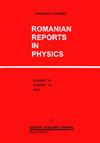使用恒星吞噬机制的大质量黑洞生长
IF 2.2
4区 物理与天体物理
Q2 PHYSICS, MULTIDISCIPLINARY
引用次数: 0
摘要
“合并黑洞(BHs)的演化及其相关过程将是即将到来的引力波(GWs)天文台的核心研究,包括欧洲航天局的LISA太空任务。我们专门为研究黑洞的增长进行了模拟,以便为未来的GW实验室提供有关检测率的估计。在这里,我们描述了我们对黑洞生长的一种新实现的研究结果,恒星吞噬(SG),其中恒星被黑洞吸收。目前的科学文献强调黑洞成长的两种主要机制:周围物质的吸积和与另一个黑洞的合并。通过考虑这两种方法,人们可以开始模拟从起源到当前观测的最大质量黑洞(MBHs)的生长过程。我们之前的工作表明,即使你考虑到这些过程的最大值,也很难将黑洞增长到我们今天测量的质量和浓度。因此,我们进行了详细的模拟,以研究另一种生长机制,即恒星吞噬(SG),它有可能增加黑洞的质量。”本文章由计算机程序翻译,如有差异,请以英文原文为准。
Massive black hole growth using the star gulping mechanism
"The evolution of merging black holes (BHs) and their associated processes will be the center-piece study for the upcoming gravitational waves (GWs) observatories, including the LISA Space Mission from ESA. We ran simulations specifically for studying the BH growth, in order to provide estimates regarding the detection rates for the future GW laboratories. Here, we describe the results of our investigations for a new implementation regarding the BH growth, star gulping (SG), in which stars are absorbed by BHs. The current scientific literature emphasizes two main mechanisms for the growth of BHs: accretion of surrounding material and merging with another BH. By taking into account both methods, one can begin to model the growth processes of the most massive BHs (MBHs) from the moment of their origin to current observations. Our previous work showed that even if you consider these processes at their maximum, it is very difficult to grow BHs to the masses and concentrations that we measure today. Therefore, we performed detailed simulations in order to study another growth mechanism, star gulping (SG), that has the potential to add more mass to BHs."
求助全文
通过发布文献求助,成功后即可免费获取论文全文。
去求助
来源期刊

Romanian Reports in Physics
物理-物理:综合
CiteScore
4.20
自引率
29.60%
发文量
0
审稿时长
4-8 weeks
期刊介绍:
Romanian Reports in Physics is a journal publishing physics contributions in the fields of:
1. Mathematical and General Physics
2. Nuclear Physics. Particle Physics. Astroparticle Physics
3. Atomic and Molecular Physics
4. Plasma Physics
5. Condensed Matter
6. Optics & Quantum Electronics
7. Biophysics & Medical Physics. Environmental Physics
8. Physical Methods and Instrumentation
9. Earth Physics
 求助内容:
求助内容: 应助结果提醒方式:
应助结果提醒方式:


